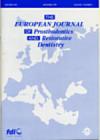European Journal of Prosthodontics and Restorative Dentistry

- Cover Date:
- March 2006
- Print ISSN:
- 0965-7452
- Vol:
- 14
- Issue:
- 1
Partial Edentulism and Removable Denture Construction: a Frequency Study in Jordanians
Abstract - This study aimed to investigate the frequency of different classes of patterns of partial edentulism and the most frequently used design components of conventional cobalt-chromium RPD constructed for patients attending a dental teaching hospital in Jordan. Two- hundred laboratory authorization forms were reviewed. Of the total 200 patients (150 male, 48 females, mean age 44.5 years), 150 patients had both maxillary and mandibular Co-Cr RPDs constructed with a total number of frameworks sums to 350. Kennedy classiï¬cation was followed to identify the class of partial edentulism. Of the total 350 patterns, Kennedy class III was the most common classiï¬cation encountered in maxilla (47%) and in the mandible (45%). Among combinations, maxillary Kennedy class III classiï¬cation opposing mandibular class III was the most common combination (30%). The lingual bar was the most frequently designed major connector (77%), while palatal strap was the most common connector in the maxilla (38%). Signiï¬cantly (p<0.05), patterns with Kennedy class II and III were more frequent among males than females. The most common type of direct retainer used was the circumferential clasp in both maxillary and mandibular RPD’s. On the other hand, ring clasps were used three times more frequently in mandibular RPD frameworks compared to maxillary RPD’s. The RPI clasp assembly was used in class I and class II situations in 75% of cases more common in the mandible. It is concluded that the variations in construction of RPD design concepts with international studies reflects the influence of teaching philosophy and diversity of faculty members’ backgrounds. KEY WORDS: Kennedy classiï¬cation, Maxilla, Mandible, Connector, Modiï¬cation, Jordan
Introduction
Several studies of trends in removable prosthodontic service showed that the number of complete dentures is declining, the number of removable partial dentures is increasing and the fast growing prosthesis constructed was the combination of maxillary complete denture opposing mandibular removable partial denture1,2. This reflects the changes in dental treatments provided which encourage the preservation of natural teeth and the decrease in the number of cases require complete dentures. Removable partial denture treatment should be provided when health beneï¬ts to be derived outweigh the risks, inconveniences, or burdens involved 1. A removable partial denture may be needed to restore the functions of natural teeth and their supporting tissues which have been lost, and preserve the remaining teeth. Denture design should prevent drifting, tilting, and over eruption of the remaining natural teeth, improve distribution of occlusal load, prevent an imbalance in the neuromuscular equilibrium, and generally contribute to the normal function of the stomatognathic system3. Several studies showed great variations among dentists in the same country in removable partial denture (RPD) designs as it the case among different regions of the world 3,4 . It is widely accepted that the design of removable partial dentures is a clinical responsibility. However, dentists sometimes fail to observe their responsibility in this regard and instead delegate the task of designing dentures to technicians5,7,8,9.
BDS, PhD(UK)
The need for creating a classiï¬cation system for partially edentulous arches is to enable the dentist to clearly communicate to a listener or a reader about the condition of an oral cavity in which missing teeth are to be replaced with a prosthesis2. Another beneï¬t of a practical classiï¬cation system is that it helps in the learning of the fundamentals of design. In treatment planning for partial denture management, we must give considerable thought to the partial denture design which will best replace missing teeth, and which restore dental functions with the least harmful effect on the supporting structures11. Despite these principles, there are still wide variations in different parts of the world among clinicians regarding the concepts of removable partial denture designs 5. But the golden rule is that although there are different schools of thought regarding the appropriate design, the patient should be provided with a prosthesis that preserves the health of what remains. The aims of this study were to investigate the frequency of different classes of patterns of partial edentulism and the most frequently used designs of conventional cobalt-chromium RPD constructed for patients attending the Prosthetic clinic in a Dental Teaching centre in Jordan University of Science and Technology, Irbid, North Jordan during a period of two years and relate this to the age and sex of the patients. Irbid is the second largest city in the North after the Capital and the dental centre is the only educational centre allocated in the north.
EJPRD-615-AL-Dwairi.indd 13
28/02/2006 15:18:56
- Article Price
- £15.00
- Institution Article Price
- £
- Page Start
- 13
- Page End
- 17
- Authors
- Ziad N. AL-Dwairi
Articles from this issue
- Title
- Pg. Start
- Pg. End
- Effect of Five Staining Solutions on the Colour Stability of Two Acrylics and Three Composite Resins Based Provisional Restorations
- 2
- 6
- Surface Microhardness of a Resin Composite: a Comparison of a Tungsten Halogen and a LED Light Curing Unit, in vitro
- 7
- 12
- The effect of cooking method upon the titratable acidity of a popular vegetarian dish – Scope for reducing its erosive potential?
- 28
- 31
